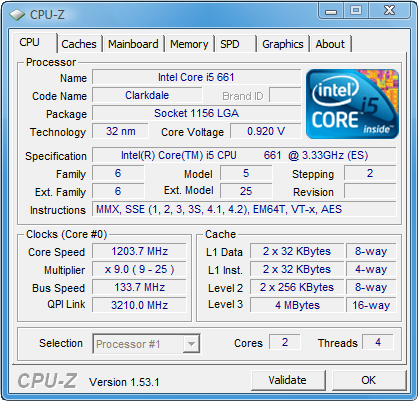Clarkdale Efficiency: The Perfect Clock Rate For Intel's Core i5-661
Clarkdale And Turbo Boost
Intel currently has four Core i5 desktop dual-core processors at 3.2, 3.33, and 3.46 GHz. They all support the Turbo Boost feature, which means that the peak clock speed may be higher if there is sufficient thermal headroom and a high processor load. The following table provides the full overview on all processors currently available that are based on the Nehalem architecture:
Intel's Nehalem / Westmere Lineup For Q1/2010
| Model | Code Name | Clock | Max. Turbo | HT | CMOS | Cores /Threads | Power | Price |
|---|---|---|---|---|---|---|---|---|
| Core i7-975 Extreme | Bloomfield | 3.33 GHz | 3.6 GHz | Yes | 45nm | 4/8 | 130W | $999 |
| Core i7-950 | Bloomfield | 3.06 GHz | 3.33 GHz | Yes | 45nm | 4/8 | 130W | $562 |
| Core i7-920 | Bloomfield | 2.66 GHz | 2.93 GHz | Yes | 45nm | 4/8 | 130W | $284 |
| Core i7-870 | Lynnfield | 2.93 GHz | 3.6 GHz | Yes | 45nm | 4/8 | 95W | $562 |
| Core i7-860 | Lynnfield | 2.8 GHz | 3.46 GHz | Yes | 45nm | 4/8 | 95W | $284 |
| Core i5-750 | Lynnfield | 2.66 GHz | 3.2 GHz | No | 45nm | 4/4 | 95W | $196 |
| Core i5-670 | Clarkdale | 3.46 GHz | 3.73 GHz | Yes | 32/45nm | 2/4 | 73W | $284 |
| Core i5-661 | Clarkdale | 3.33 GHz | 3.6 GHz | Yes | 32/45nm | 2/4 | 87W | $196 |
| Core i5-660 | Clarkdale | 3.33 GHz | 3.6 GHz | Yes | 32/45nm | 2/4 | 73W | $196 |
| Core i5-650 | Clarkdale | 3.2 GHz | 3.46 GHz | Yes | 32/45nm | 2/4 | 73W | $176 |
| Core i3-540 | Clarkdale | 3.06 GHz | N/A | Yes | 32/45nm | 2/4 | 73W | $133 |
| Core i3-530 | Clarkdale | 2.93 GHz | N/A | Yes | 32/45nm | 2/4 | 73W | $133 |
| Pentium G6950 | Clarkdale | 2.8 GHz | N/A | No | 32/45nm | 2/2 | 73W | $ 87 |
The 661’s graphics unit runs at 900 MHz while all other current i3/i5 models run at 733 MHz. We believe that the additional GPU speed is not a must-have feature, since few people would actually purchase a system with integrated graphics to run 3D-intensive applications or games. If you ask us, you should either choose one of the 73W models for multimedia systems or buy a discrete graphics card if you're planning on serious gaming. Although Intel has made quite a step forward here, integrated graphics still won’t impress anyone with enthusiast cred.
The main difference between Core i3 and i5 is the absence of Turbo Boost on Core i3. In addition, the Core i5 desktop processors all support Intel’s AES New Instructions (AES-NI) to accelerate encryption or decryption; Core i3 doesn’t, nor do its clock speeds reach as high. Still, due to Core i3's low price points and the fact that low-end chip overclocking margins that are typically only slightly behind the faster models, these should provide great bang for the buck.
Turbo Boost in Action
Turbo Boost can accelerate the Core i5-661's processor clock by one 133 MHz clock speed increment for both cores, or by two speed bins for a single core.
The idle clock speed of 1,200 MHz is set by the SpeedStep feature, which kicks in when there is little or no work for the processor to do.
Get Tom's Hardware's best news and in-depth reviews, straight to your inbox.
The nominal clock speed of 3.33 GHz is either reached during normal operation with constant processor load or if thermal conditions prevent Turbo Boost from accelerating the processor any further. In the screenshot above, Turbo Boost provides an additional 133 MHz (3.46 rather than 3.33 GHz) for both cores.
If we throw a single-threaded workload at the CPU it will accelerate by two 133 MHz speed increments, to 3.6 GHz.
Since Turbo Boost is a very handy, practical feature, we believe it makes sense to overclock the processor in a way that maximizes Turbo Boost speed, but leaves the nominal speed considerably lower for the sake of power consumption. Traditional overclocking sets the CPU to a fixed clock speed, which may be fast, but is also inefficient.
Current page: Clarkdale And Turbo Boost
Prev Page What’s The Perfect Clock Speed For Intel’s New Dual-Cores? Next Page Overclocking BCLK To 140 And 148 MHz

